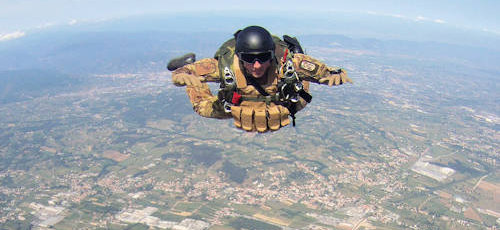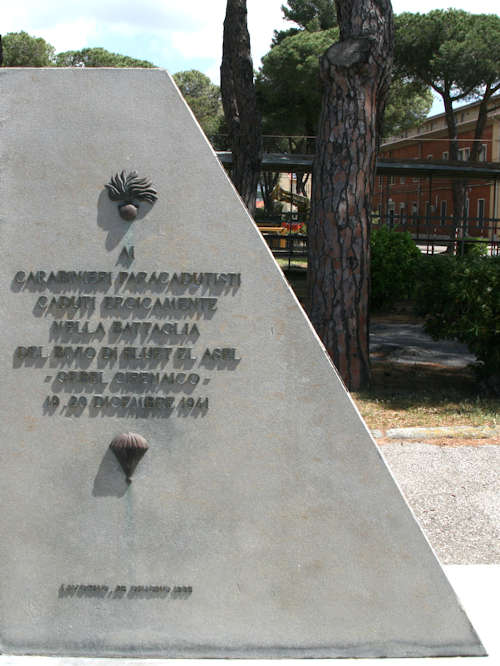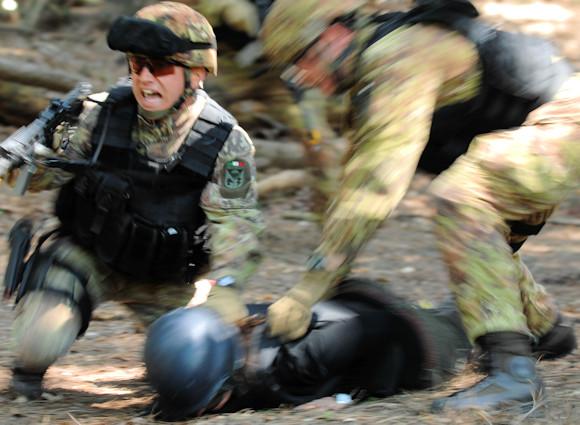Men of excellence, those of our armed forces and, in this case, of the carabinieri. In a normal country they should be thanked every day for the work they do in Italy and abroad, for their dedication to citizens, for the respect of the rules and institutions (and a "civilian" is allowed to say that they do in silence, despite certain institutions and certain citizens, those who "shoot" the uniforms by "party" taken, the pseudo intellectuals, the pseudo pacifists, the pseudo ... and that's it ...). To be thanked above all because they need a country that one should not be ashamed to call homeland and because they honor a tricolor that is the emblem of that homeland, because they keep Italianity high in the world. They are the paratroop carabinieri of the first Tuscania regiment.
Those who aspire to enter Tuscania, of all grades, undergo an initial physical and psychological selection. Then, who is admitted, as an explorer, follows a nine-month course, divided into modules and then goes to the Battalion to carry out activities on the ground, operational, mission abroad, recoveries, etc. Gradually, one understands what his propensity is and decides whether or not to go to the GIS (Special Intervention Group), which makes an interpellation when he needs new staff. It can also be accessed from the other departments but always through the explorer course at Tuscania. The ten. Colonel Neil Dario, commander of the training department of the first carabinieri regiment of the Tuscania, thus synthesizes the way of a parachutist carabiniere who wants to specialize further and enter an elite: a hard training where to go forward you have to be really motivated.
"Once it was worse, it was even harder", commented some parries in a moment of pause at the coffee machines.

Observe training from the inside, share, as much as possible, a bit of life on the field with Tuscan paratrooper carabinieri and with the boys of the course Esploratori, it is a pleasure and a privilege. We met them at the Vannucci barracks in Livorno, which they share, each in their own sector, with thunderbolt e 9 ° Col Moschin. They are extremely efficient people in the area as out of the area.
Tuscania, which has a history and a highly respected medal table, today depends on the command of the mobile and specialized units "Palidoro", mobile unit division, second mobile carabinieri brigade which includes the first carabinieri parachute regiment of Tuscania, the seventh carabinieri regiment Trentino Alto Adige, the thirteenth carabinieri regiment Friuli Venezia Giulia and Special Intervention Group. The Tuscania organization chart is vast: regiment, command office, sections such as logistics, administration, health, etc. The training department (of which Lt. Col. Dario is the commander) and the command and services company for logistical support are directly under the command of the regiment. The parachute carabinieri battalion is divided into three companies plus the command, for the fulfillment of institutional tasks and for planning and specialist training and adherence support section. Companies are divided into platoons and squads.
The amaranth Basques of Tuscania are one of the excellences of our armed forces. They are at the same time Territorial weapon because carabinieri and military because paratroopers. They participate in missions abroad, train foreign armed forces, manage the stockpiles of officials and diplomats (and also journalists) intended to operate in areas of crisis and contribute to the security devices of the diplomatic offices at risk. They support the Special Intervention Group. Tuscania also hosts courses for hunters carabinieri: after Calabria and Sardinia, on May 13 the heliported carabinieri squadron was officially established in Sigonella hunters of Sicily.
Commander Dario, how does the selection come to Tuscania?
As a training department we make "at home" selections in the various schools, those for police marshals as well as officers, with physical selection tests according to well-defined criteria. There a first screening takes place which then continues at the National Selection and Recruitment Center with medical examinations, psychometric tests and interviews. When they arrive at the training department and retake the physical admission tests, someone does not pass them, despite the previous selection. Obviously, those who want to enter Tuscania are already informed, they already know that they must prepare physically, they know that to get the maximum score they must do 15 pull-ups, 15 parallel pushups or 1.500 meters, as a running test, in five minutes, as well as pushups. with the slap for coordination because it is an important aspect, as well as the 35 pushups in one minute, 25 meters in freestyle, 25 in breaststroke and 4 minutes of static float in a vertical position. Things that are overcome, but those who have never done so reach the fifth draw and stop, if they are not trained. We have a minimum and a maximum selection criterion. Whoever goes below the minimum is out immediately. Each selection is scored for each test carried out, scores which are then added together. Only if the final count is greater than 1.257 is the selection exceeded. Let's make a single table. It must be said that this is the minimum to be able to access the training activity, because we cannot start with a fasting on everything and then "build" him to become a half athlete. A person must already be able to move in a certain way.
You have to have a minimum basic physical construction. If we started with a low level, we would not be able to move forward. So let's start with a level as high as possible. Since the beginning of the explorer courses, aquatic tests have also been included, because when wading activities, crossing rivers, etc., the personnel that does not float is a problem. We cannot teach to swim, we must already know how to do it, show that we are comfortable in the water and know how to float.
So admission tests follow precise parameters?
As a basis, we have the same references that apply to the admission tests to the SMIPAR parachuting course in Pisa. We do about a month of training, with the last week dedicated to jumps, for the achievement of the qualification of military paratrooper. It is also true that the launches are linked to weather conditions which, if adverse, delay the start of the training activities already scheduled, divided into packages scheduled day by day. The instructor staff follows the students. Today, for example, we have 28 people on the ground with an activity already planned in the previous days. You have to organize it, it's not like you wake up in the morning and decide at the moment. The planning is annual: with a course lasting 41 weeks - almost ten months of training including the parachuting course - everything is planned, from the training areas to the activities to be carried out.
 You of Tuscania are first paratrooper carabinieri, so the launches are fundamental ...
You of Tuscania are first paratrooper carabinieri, so the launches are fundamental ...
Yes, for the "military parachuting patent", Five launches with a tie rope make the star, only three launches assign the qualification of "paratrooper". The difference is only from the point of view of the patent, with the star or without. The last two launches, made with equipment, weapon and backpack, assign the military patent. Then, if you talk a bit 'of activities of CL, ie the freefall launch, that is another course, carried out on another step, with the appropriate staff that shows more propensity to this activity, based on the seats available at the Military parachuting school of the Folgore Brigade. However, the basis for becoming a paratrooper carabiniere is also to obtain the military parachuting patent. If during the course one arrives at the door and refuses to throw himself, he pulls him in, makes him sit down and the next day he goes home. You can not be from Tuscania if you are not a paratrooper.
The selection in this sense comes already with the simulations, for example with the towers that are at the school of Pisa, 18 / 20 meters high, which simulate the entry into the cabin of the plane where one is hooked with harness and steel cables. You must learn to understand and manage emergencies, understand when to open the auxiliary parachute, whether it is a closed pack or flame, etc. These are the basic criteria that we skydiving teachers do at the end of the first training phase, the first three months, selectively. At this point, rough, we will have already understood the qualities of the staff that we decide to continue.
By entering the merits of the selective set, what are the training packages?
The selection takes place through ten packages for the first training phase and nineteen for the second. At the end of the two to three month first stage, there is the one month skydiving course. Then we start again with the second six-month cycle. If you fail only one test you are not eligible. During the stay, it is natural that the physical abilities increase. There are continuous checks: use of weapons, other physical tests such as the 4-meter wall where you go up and down with the spider technique, the ability to move on the territory alone and in groups. It is important that the student has a thinking head to avoid any kind of problems for himself and others. They are monothematic packages that include survival, resistance to interrogation, countering the threat and guerrilla warfare. At the end, the personnel who pass and arrive at the end of the training, become paratrooper carabiniere with the qualification of "Explorer", a very specific qualification.
 When it comes to technology, are you equipped with weapons, means and particular radio sets?
When it comes to technology, are you equipped with weapons, means and particular radio sets?
Among the weapons supplied, we now have the M4 Bushmaster, an assault rifle, which is a weapon on the platform of which numerous shooting aid systems can be installed: from the grenade launcher to the night vision device, to the laser pointer and shooting, everything. It is prepared as needed. Then there is also the Minimi, light machine gun as a team weapon, of immediate support, there is the MG as a medium heavy support weapon, there is the Browning 0.50, as there is the 40 mm automatic grenade launcher, etc. Based on the activities there is a configuration, you take a type of armament and use it. There are 12-gauge shotguns, sniper weapons for sharpshooters, it depends on what you go for. There are qualified marksmen and there are those who have other qualifications: when there is an activity, it depends on the operating environment.
Obviously in Italy we do not go around with weapons of war use. There is a team that works with M4, with 12 or 9 caliber, only weapons of a certain type are used and only in extreme cases. For work on the territory we also have radio frequencies for interfacing anywhere between carabinieri and night viewers.
The GIS (Special Intervention Group): to be admitted you must in any case pass through Tuscania. Yours is almost "raiders" training, but on paper you are not ...
Currently, those who want to go to the GIS must first go to the Tuscania training activity and then adhere to the interpellations regarding the entrance fees for their basic course.
We on paper are not "raiders". Ours is an advanced and specialized training, because we operate in various environments: we operate in the air with a parachute, we operate on the snow in the mountains, in the water because we have specialized in various activities. But - I repeat - we are not raiders on paper. Personnel take their first explorer qualification. It is a first step, perhaps, to evolve in some way. But we are different from the raiders. For example, the 9th (Col Moschin) works as a special force and with a certain criterion and type of employment, the GIS is a special force but also has a police job.
 You are carabinieri but also operate as military, as well as on the territory ...
You are carabinieri but also operate as military, as well as on the territory ...
Yes, we are the only carabinieri department that has this type of training. I would say we are multi-task. We have dual training, military and police. Military training, because we are paratroop carabinieri and we also have duties with jobs in international environments. However, the personnel must also operate in support of the territorial weapon and there you do not go with a grenade launcher, you go with weapons for use in an urban environment. The rules change, everything changes. Men must be able to switch from cambact mode to territorial police mode. This is important.
And in case of terrorism?
It could not be done even in the event of a terrorist threat, because it operates on the basis of provisions that are issued specifically. In case of terrorism, hostage release, etc, the primary use is of GIS and we go to support. The Tuscania is used in Italy to assist the Special Intervention Group, who intervenes, carries out a police operation and we carry out support activities. It is logical: they must operate in a compartmentalized environment, we close the external area with a belt, while the territorial weapon makes the widest belt. We secure the area of operation around which we take a position. GISs intervene in an environment without thinking too much about what is around. As mentioned, the Territorial Weapon protects the outermost area. All this is also done to prevent someone from arriving, perhaps a distracted civilian on the phone, who finds himself in the middle of an operation. It happens. Everything must be budgeted.
Above all abroad you take care of check points and inventory management. Do you also collaborate with special forces such as 9 ° Col Moschin or the GOI (Incursori Operational Group, ed)?
We do not cooperate with them because we are not within the special forces. In an international context, what is going on in the job abroad, whether in training or otherwise, depends. Now, our employment outside of Italy is in the work of police training, while we have a lot of staff, over one hundred units, employed for stocks at risk embassies. We are in Iraq, Lebanon, Afghanistan, and many other places. Where are the diplomatic offices at risk, we have those who escort the ambassador. At this time, we are pursuing a lot of Palestinian, Djibouti, and Inherent Resolve missions in Iraq, in Baghdad, where we are trained, with a police task force, at local police forces. The findings look good. Teams are now emerging on the ground in the various provinces of Iraq to see whether the training is successful or not on the Iraqi police forces themselves.
Can we say that, given the resources available, do miracles to maintain the level of excellence?
It is not easy to have the staff for the activities. That too is a problem. We, like the Battalion, make miracles with the forces available. We carry on an operational and training activity that is not indifferent and that is constant, always tough. The staff is always employed, continuously, maybe four months abroad, then six more - at most - in Italy, then again out, re-employed, otherwise you can not cover the programmed activity. Whoever goes here is trained and prepared but, for example, we have few officers who have to cover so many activities and there are few people in the field. For us it is not a question of cuts, but of organization. The difficulty therefore concerns organizational and training activities. The rules are made for those who work in the office, for those who are operational are a problem.
 Speaking of problems, do you also have that of the other armed forces and the police where the average age is 35 years and more? If so, is not it high for an operational level like yours?
Speaking of problems, do you also have that of the other armed forces and the police where the average age is 35 years and more? If so, is not it high for an operational level like yours?
The 35-year limit is quite high. But the average age of Tuscania is also 40 years. Last year and this, we selected 23, 24 year old pupils from schools to start lowering this average. There would also be personnel who have been selected by the territorial weapon, but at the moment we are not inserting them because they reach 32-35 years and we are preferring a lower age. Those who come from school pupils have already done military service and it means that they are already 24, 26 years old. Once the auxiliary carabiniere was 19 years old and entered the Academy at 20. In recent competitions, seats have been reserved for civilians. This will perhaps allow you to lower your age.
Here at the first Tuscania carabinieri regiment you also have the sports skydiving section.
In the past they have had great international feedback. Founded in '76, they make precision landing, figures, evolutions. They have achieved remarkable results, won world championships with gold medals, military world championships, European and Italian championships. The medal table of the sports parachuting section is really high. It is not easy to jump from a thousand meters and land on a "coin". They depend on me as their first job but they are dedicated exclusively to activities aimed at competitions. They are athletes, their job is to train.
Tuscania is an excellence and also a peculiarity ...
So far, we are a regiment of parachutist carabinieri with basic infantry capacity, according to the military order. But, no doubt, Tuscania is a really special reality.
(teacher)












